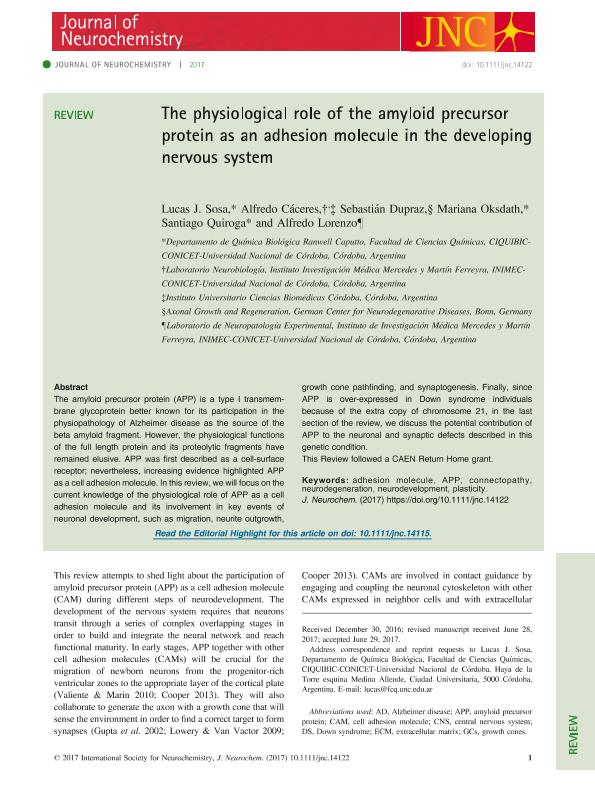Artículo
The physiological role of the amyloid precursor protein as an adhesion molecule in the developing nervous system
Sosa, Lucas Javier ; Caceres, Alfredo Oscar
; Caceres, Alfredo Oscar ; Dupraz, Sebastian, Enrique
; Dupraz, Sebastian, Enrique ; Oksdath Mansilla, Mariana
; Oksdath Mansilla, Mariana ; Quiroga, Santiago
; Quiroga, Santiago ; Lorenzo, Alfredo Guillermo
; Lorenzo, Alfredo Guillermo
 ; Caceres, Alfredo Oscar
; Caceres, Alfredo Oscar ; Dupraz, Sebastian, Enrique
; Dupraz, Sebastian, Enrique ; Oksdath Mansilla, Mariana
; Oksdath Mansilla, Mariana ; Quiroga, Santiago
; Quiroga, Santiago ; Lorenzo, Alfredo Guillermo
; Lorenzo, Alfredo Guillermo
Fecha de publicación:
15/10/2017
Editorial:
Wiley Blackwell Publishing, Inc
Revista:
Journal of Neurochemistry
ISSN:
0022-3042
e-ISSN:
1471-4159
Idioma:
Inglés
Tipo de recurso:
Artículo publicado
Clasificación temática:
Resumen
The amyloid precursor protein (APP) is a type I transmembrane glycoprotein better known for its participation in the physiopathology of Alzheimer disease as the source of the beta amyloid fragment. However, the physiological functions of the full length protein and its proteolytic fragments have remained elusive. APP was first described as a cell-surface receptor; nevertheless, increasing evidence highlighted APP as a cell adhesion molecule. In this review, we will focus on the current knowledge of the physiological role of APP as a cell adhesion molecule and its involvement in key events of neuronal development, such as migration, neurite outgrowth, growth cone pathfinding, and synaptogenesis. Finally, since APP is over-expressed in Down syndrome individuals because of the extra copy of chromosome 21, in the last section of the review, we discuss the potential contribution of APP to the neuronal and synaptic defects described in this genetic condition. (Figure presented.). Read the Editorial Highlight for this article on page 9. Cover Image for this issue: doi. 10.1111/jnc.13817.
Archivos asociados
Licencia
Identificadores
Colecciones
Articulos(INIMEC - CONICET)
Articulos de INSTITUTO DE INV. MEDICAS MERCEDES Y MARTIN FERREYRA
Articulos de INSTITUTO DE INV. MEDICAS MERCEDES Y MARTIN FERREYRA
Citación
Sosa, Lucas Javier; Caceres, Alfredo Oscar; Dupraz, Sebastian, Enrique; Oksdath Mansilla, Mariana; Quiroga, Santiago; et al.; The physiological role of the amyloid precursor protein as an adhesion molecule in the developing nervous system; Wiley Blackwell Publishing, Inc; Journal of Neurochemistry; 143; 1; 15-10-2017; 11-29
Compartir
Altmétricas



